Planner: Cui Guo Author: Lisa
The Smart Cities Challenge, a contest run by Infrastructure Canada, is intended to spark innovation in communities around the country. $75 million will be used to fund four projects in different size municipalities. The Challenge initially received 130 applications, and 20 of those applications were chosen as finalists by the Challenge Jury, each of which received funds to develop their finalist proposal. In May 2019, four contest winners were announced.
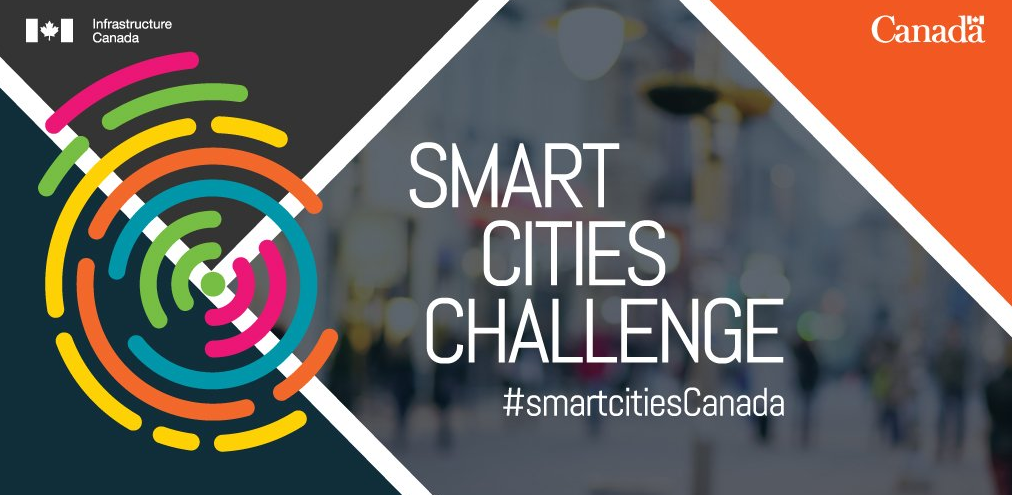
Picture Source: https://smartcities.edmonton.ca/final-proposal
Smart Cities Challenge Winners
$5 million winner – Town of Bridgewater, Nova Scotia
Bridgewater will install energy monitoring and communications equipment in over 1,000 low-income homes, improve transportation systems, develop an energy retrofit financing program, and increase clean tech training and literacy. The ultimate goal is to reduce the energy poverty rate by 20% by 2025.
$10 million winner – Nunavut Communities, Nunavut
This community plans to increase residents’ digital connectivity to improve access to mental health resources and support systems. Resources will include a culturally specific digital literacy curriculum, makerspaces, mobile applications, gamified initiatives, and digital art therapy.
$10 million winner – City of Guelph and County of Wellington, Ontario
With the goal of creating a circular food economy, this community will improve become a living lab to explore ways of improving access to nutritious food, and turning "waste" into a valuable resource. This project will be make use of big data and a suite of digital tools.
$50 million winner – City of Montréal, Quebec
This project focuses on mobility with a neighbourhood focus to improve food access across the city. By providing transportation alternatives such as on-demand car sharing, autonomous vehicles, and bike sharing, this project will reduce the use of automobiles and increase food access. This project will also address citizen engagement and governance to support collective decision-making.
Analysis of the 20 finalist applications suggests that health and well-being is a key concern for many Canadian communities. Of the 20 Finalist applicants, 9 identified “Healthy Living and Recreation” as a theme of their proposal. This article will discuss three of the finalist applications – the cities of Airdrie, Edmonton, and Côte Saint-Luc – and will reflect on what challenges these cities face, and how they hope to use smart technology and connected data to overcome these challenges.
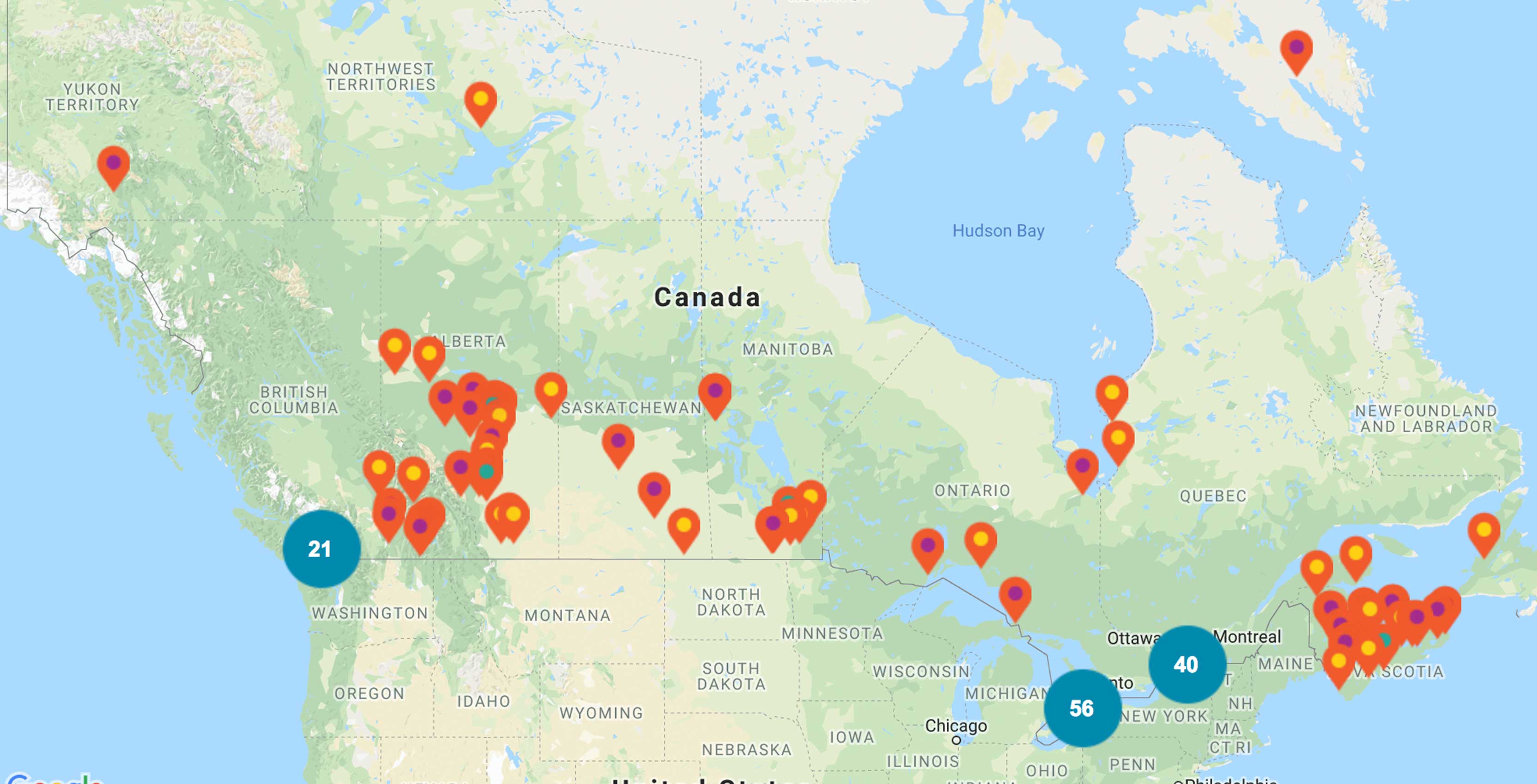
Picture Source: https://mobilesyrup.com/2018/05/16/canada-smart-cities-challege-list
Edmonton
Challenge Statement:Edmonton will lead the transformation of Canadian healthcare using an unprecedented municipal approach by focusing on leveraging relationships, health data and innovative technologies to provide a personalized health connection and experience as unique as the health of every Edmontonian.
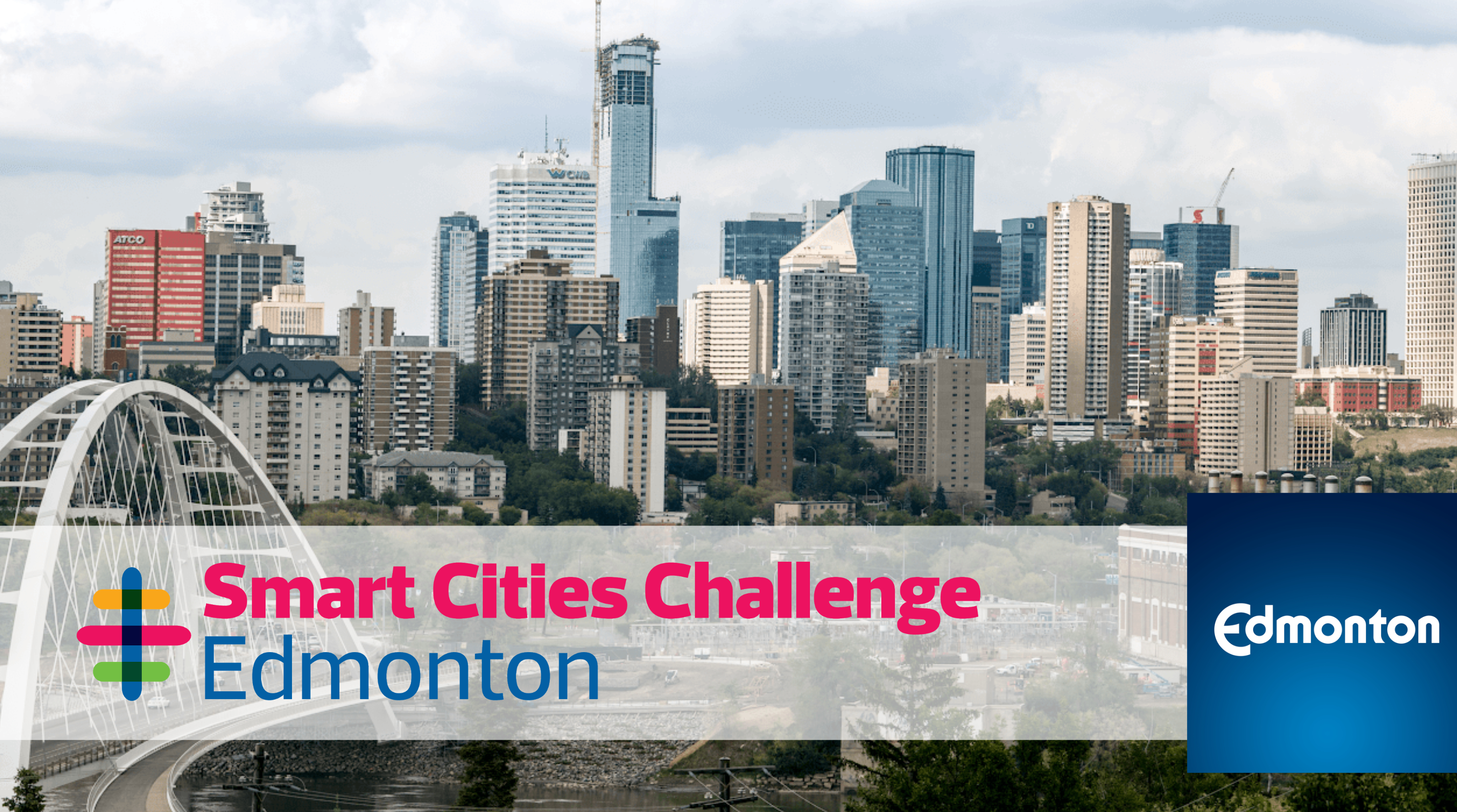
Picture Source: https://livestream.com/asquaredtv/events/8589683
The overarching goal of Edmonton’s Smart Cities Challenge application is to improve residents’ quality of life by improving their health and wellbeing. In their preliminary proposal, Edmonton contextualizes their application, pointing to the key role that urbanization and city services play in resident health. Although the Provincial governments are primarily responsible for health care, cities provide services, programs, and develop policies that have an effect on resident health. City governments can help create urban settings that encourage healthy behaviours and “connect residents with each other physically, spiritually and emotionally and support them in living healthy, safe and joyful lives.” Edmonton intends to provide this support by creating a Healthy City Ecosystem in partnership with academics, industry, government, and citizens.
Their goal is to create an integrated health support system that prevents negative health outcomes by addressing the social determinants of health including loneliness, connectedness, and a sense of belonging. Edmonton proposes a variety of technological interventions, including the creation of a Health Data Repository, where different datasets are collected, analyzed, and shared between partners. Anonymity of heath data is a central principle of this repository, as is the facilitation of analytics and data mining, and ensuring equitable access. Edmonton says that this initiative would be transformational, because health data is typically kept separate and used by different practitioners and health authorities. Another proposed technology in Edmonton’s application is a digital tool that would allow residents to access information about services, and connect with the larger community.
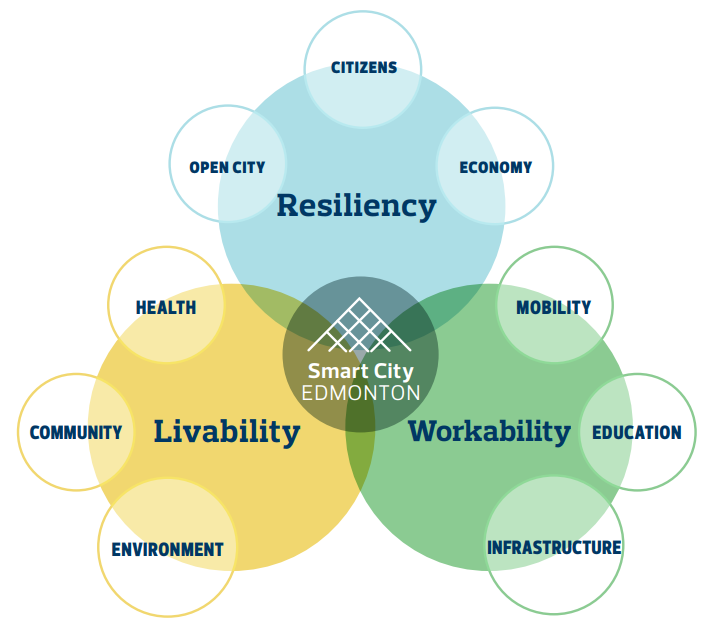
Picture Source: https://www.edmonton.ca/city_government/documents/PDF/Smart_City_Strategy.pdf
In their finalist application, Edmonton adds an additional proposed outcome: “To transform how municipalities across Canada work with residents to achieve excellence in data and technology.” The city is a leader in the municipal use of technology and data, having been named Canada’s Most Open City, a Top 7 Intelligent Community of the Year, winner of the Gold WeGo Smart Sustainable City Award, and is the first Canadian city to win the IBM Smarter Cities Challenge award, and the first Canadian pilot of Johns Hopkins University’s Centre for Government Excellence What Works Cities initiative. They propose establishing a formal program through which they would continue to advance knowledge in these areas and share this knowledge with other cities. This program would be a “municipal-focused digital innovation collective” that worked to build capacity for citizen-driven open data and analytics for cities across Canada.
Airdrie
Challenge Statement:Become Canada’s healthiest community, by engaging and securing the participation of all in the community to create a community healthy culture that improves social, economic, physical and health care environments and individual characteristics and behaviours, so that healthy life expectancy is increased by 3+ years over 5 years.
Airdrie’s Smart Cities Challenge proposal states that health is primarily determined by factors outside of traditional health care. They cite a study conducted by the Health Foundation that concludes that “10% of a community’s health and wellbeing is linked to access to health care. The other 90% is linked to good work, our surroundings, money and resources, housing, education and skills, the food we eat, transport and family, friends and the community itself.” Recognizing that resident health can be improved outside of traditional health care, Airdrie considers how to address the social, economic, and physical determinants of health. They intend to measure, and work to improve, four areas that will inform the citizen’s health: Wellbeing, Resident and Community Engagement, Health Outcomes, and Improved Resource Use.
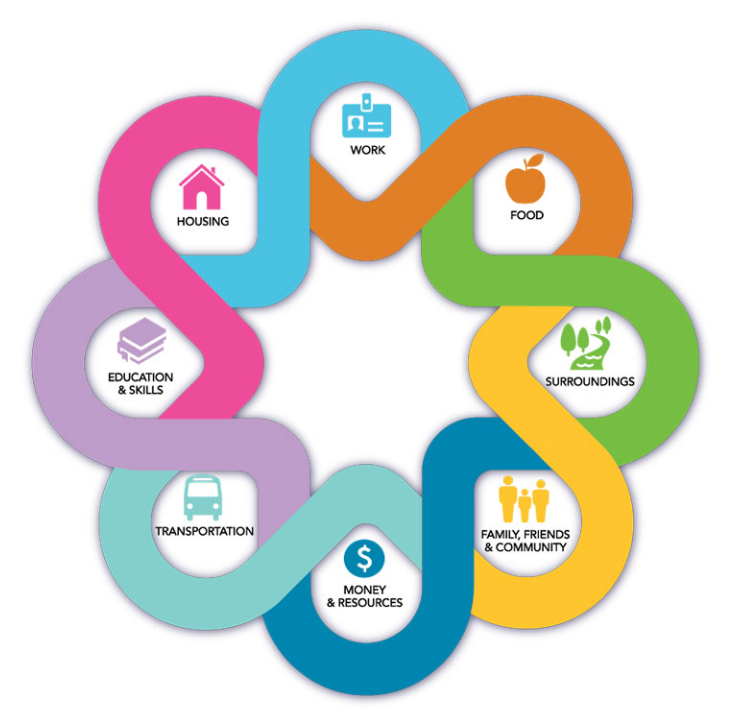
Picture Source: https://healthsmartairdrie.ca/healthy-lives
This city proposes using technology to keep residents more engaged, informed, empowered, and to facilitate their involvement in a healthy community culture. There are several smart city elements in Airdrie’s proposal, including a demonstration smart community. This is the Community Integrated Health Park, an initiative that collects community data from sensors and platforms to measure elements of wellbeing. They also intend to create a needs-based network that addresses residents with similar health care needs, as well as a technology-enabled Health Cooperative that facilitates community engagement in the project goals.
Airdrie’s finalist application shifts the focus of their proposal towards data collection and access. They plan to optimize their open data offerings, increase their use of connected technology, and build the HealthSmart Community Operating System (COS), which will support the exchange of data between individuals, businesses, and organizations. They also plan to compile an inventory of services, which would be accessible through a mobile app, web portal, and kiosks. This inventory would help increase resident use of available services. Security and privacy are essential elements of the COS and Airdrie intends to explore best practices before developing a security plan. The COS itself will not store identifiable data.
Like Edmonton, Airdrie focuses on the social determinants of health. They offer a list of eight determinants, including work, housing, food, education and skills, transportation, surroundings, money and resources, and family, friends and community. Based on the results of a resident survey, they further narrowed their list of key social determinants, focusing particularly on surroundings, food, and friends, family, and community.
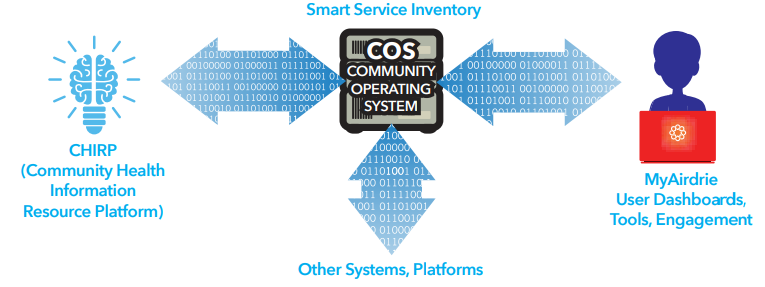
Picture Source: City of Airdrie Smart Cities Challenge Submission
Côte Saint-Luc
Challenge Statement:Our city will provide socially isolated seniors with confidence they can live more autonomously, secure in the knowledge that the city is looking out for their well-being.
Côte Saint-Luc’s application focuses on the health and wellbeing of seniors, who are at risk of injury, particularly when they lack family and community support. The city’s goal is to use non-invasive technology to help seniors remain in their homes. This approach is expected to meet the needs and preferences of seniors, who would often rather stay home than live in a nursing home. Assisted by technology including passive sensors that could detect falls, seniors are expected to gain both autonomy and confidence. This project is further expected to take pressure off the health care system, which is facing scarcity of available space in nursing homes and assisted-living facilities.
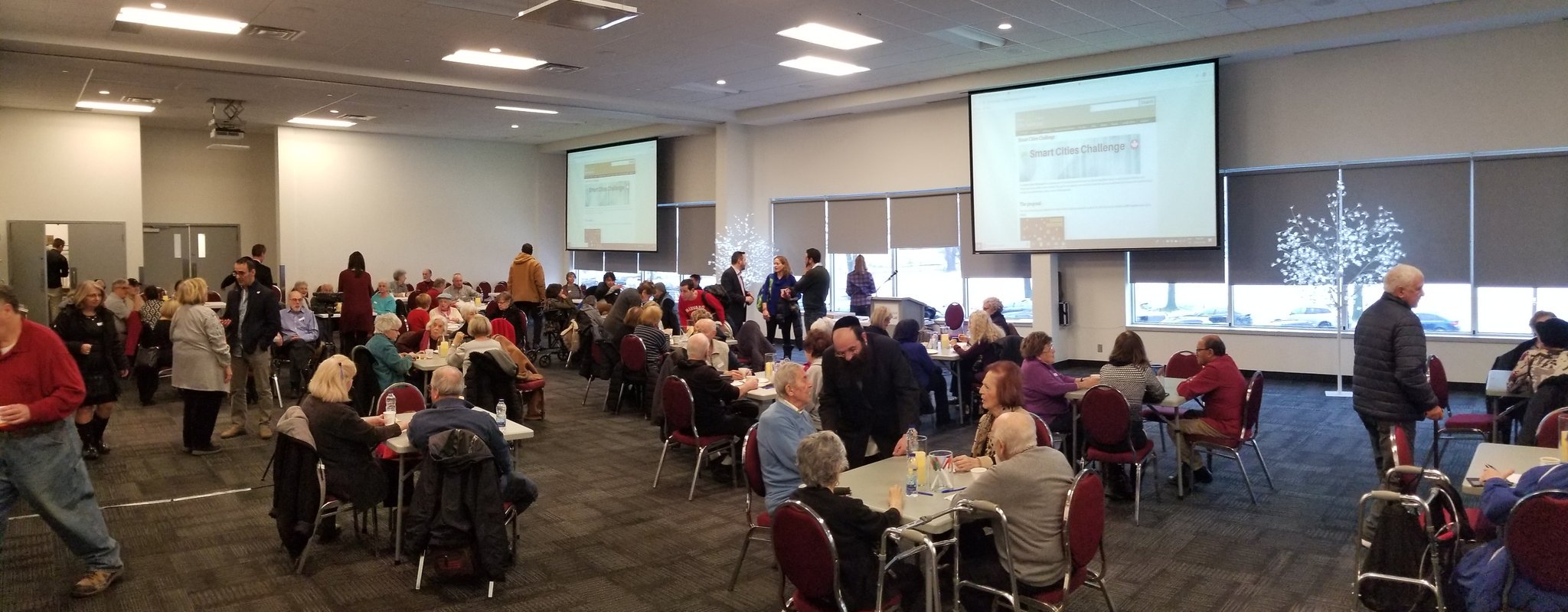
Picture Source: https://docs.wixstatic.com/ugd/c4d649_7d3a1328afa949879c7ad17d93709cae.pdf
In their initial application, Côte Saint-Luc included an environmental monitoring component, but removed it in their finalist application, opting instead to focus exclusively on improving the wellbeing of older adults. Also, Côte Saint-Luc proposes only non-intrusive technology in their initial application, stating that, for elderly people, “smart devices such as phones and tablets can become less of an aid and more of an obstacle.” However, their finalist application does propose app-enabled services, and includes information about the increasing use of technology by older adults. The City’s application maintains that technology should be convenient, simple to use, and well-adapted to the needs of older adults. They suggest that the following technologies could be included in their project: sensors, voice assistants, wearables such as smart watches, and automating technology.
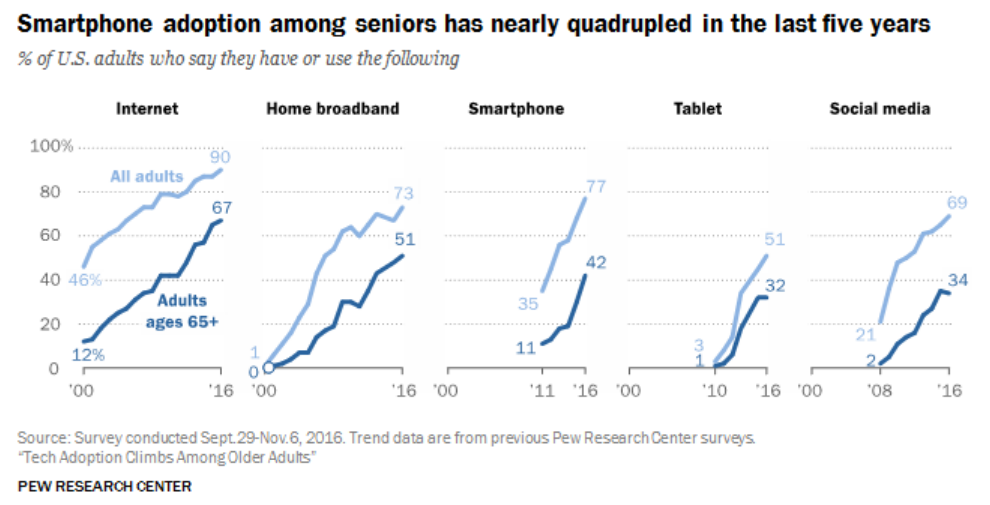
Picture Source: https://www.pewinternet.org/2017/05/17/tech-adoption-climbs-among-older-adults/
Their revised challenge statement is:
In the face of a rapidly aging population, the City of Côte Saint-Luc will implement a connected framework, leveraging smart devices and related technologies that will empower seniors to:
1. live more safely and independently in their homes;
2. be better connected to their communities and city services;
3. be more socially engaged;
Improving the overall well-being and quality of life for older adults and reducing stress on families and caregivers, the healthcare system, and long-term care facilities.
Priorities for project design include privacy and data protection. The city worked with Sharon Polsky, privacy expert and President of the Privacy and Access Council of Canada, to develop the project around the Privacy by Design concept. The finalist application states that a policy for Data Governance and Privacy Protection will be developed upon project initiation.
The Cost, and Complexity, of Health
In recent years, Canadian governments, agencies, and businesses have begun to use connected data and technology to improve health care services, delivery, and outcomes. The usefulness of emerging technologies in the health care sector is being explored by a variety of Canadian agencies. This shift is driven in part by the high cost of health care. A non-profit organization funded by the Government of Canada, Canada Health Infoway, has been mandated to “accelerate the development and adoption of modern systems of information technology, such as electronic patient records, so as to provide better healthcare” (Infoway 2015). In a 2015 report, they describe the healthcare system in Canada as a “$100-billion-plus” enterprise. There are expected to be financial benefits to this initiative: “Canada is estimated to be on track to realize $1 billion to $1.9 billion in annual benefits to the system through eliminating duplicative tests and, more importantly, reducing adverse drug events” (Infoway). The data-sharing facilitated through this project is also expected to generate “greater benefits in patient self-care, proactive disease management, reduction in wait times and overall performance management.”
The use of emerging technology in the health care sector is also motivated by the complexity of this area. For instance, the Canadian Federal Government’s Institute of Population and Public Health (IPPH) has prioritized “building research capacity to use artificial intelligence approaches” for investment. They cite the complexity of health as an explanation for its suitability for this new approach: “Many public health issues often involve complex combinations of individual, environmental, socio-cultural and political influences that are difficult to measure and evaluate using traditional approaches. However, artificial intelligence approaches like machine learning may provide us with exciting new ways to analyze complex, multi-layered, multi-modal data, and to craft solutions based on a far larger range of insights.”
The complexity of health care, as well as the multiplicity of its influencing factors, makes it an obvious choice for a smart city approach, which often involves the bringing together of different sectors and data streams, as well as innovative approaches to data analysis. There are many types of emerging technologies that can be used effectively for health care, one of which is artificial intelligence systems. While there are various current examples of artificial intelligence systems being used for diagnosis and disease prediction, these have also begun to be used to improve, and reduce the cost of, health care delivery. Researchers at the University of Toronto recently found that machine-learning techniques, such as artificial neural networks (ANN), are being leveraged within health care for a variety of reasons, including “clinical diagnosis, prediction of cancer, speech recognition, prediction of length of stay, image analysis and interpretation (e.g. automated electrocardiographic (ECG) interpretation used to diagnose myocardial infarction), and drug development. Non-clinical applications have included improvement of health care organizational management, prediction of key indicators such as cost or facility utilization. ANN has been used as part of decision support models to provide health care providers and the health care system with cost-effective solutions to time and resource management.” (Shahid, Rappon, and Berta 2019).
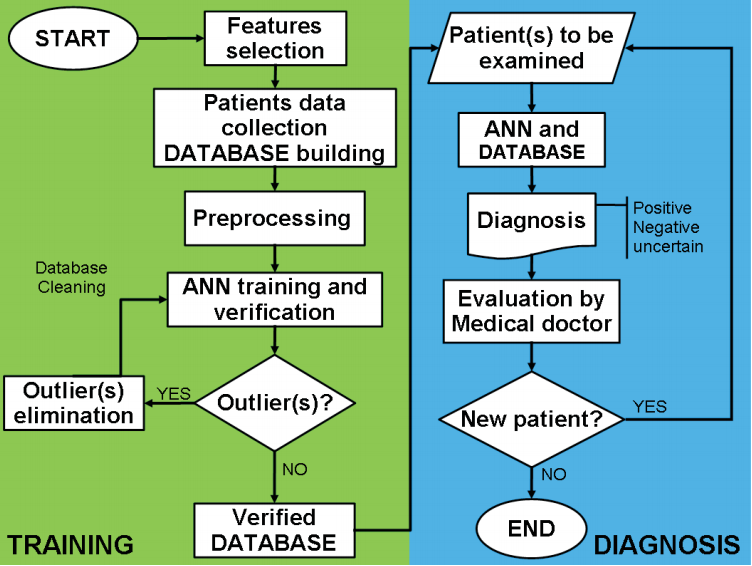
Picture Source: https:// www.zsf.jcu.cz/jab_old/11_2/havel.pdf
Health care in the Canadian Context
The importance placed on health and wellness in the Smart City Challenge applications is not surprising considering the widespread priority that Canadians place on these issues. Canadians identify health as a central concern in many contexts. For instance, a recent survey by the Bank of Canada concluded that when “asked what is most important for them and their families, … a majority (55%) [of Canadians] cite healthcare as the most important issue facing their household.” The cities that address health and wellness in their SCC applications acknowledge that health is a significant resident concern. The City of Edmonton, for instance, conducted sentiment analysis on data gathered through citizen engagement activities. The results “confirmed that Edmontonians are primarily concerned about their health and well-being and they expect the City of Edmonton to focus its efforts and resources on initiatives that will improve their quality of life.” Similarly, Airdrie “conducts annual satisfaction surveys. Health has consistently been identified as the 2nd most important issue, behind community infrastructure. We know that health and infrastructure are directly related.” Before deciding to focus on senior’s health and wellbeing, Côte Saint-Luc considered feedback from community members, as well as demographic information about the per capita number of seniors, which is higher than most Canadian cities. In their finalist application, the city states that a third of their population is age 65 or older.
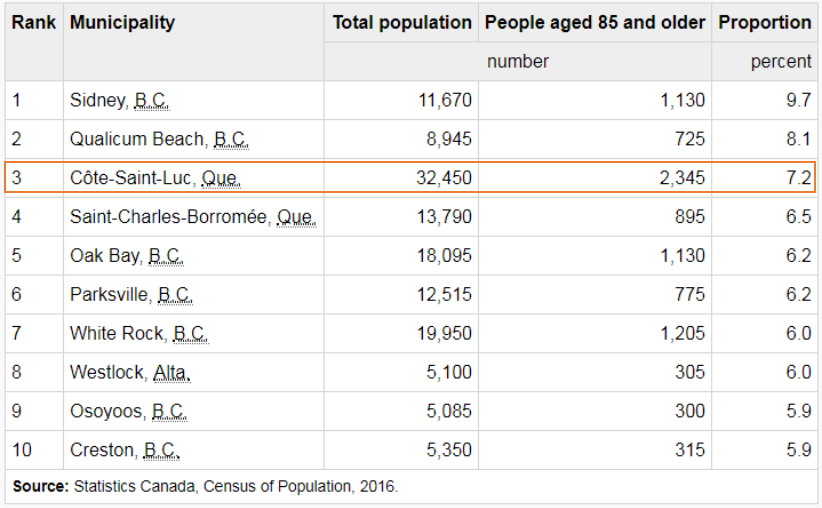
Picture Source: https://www12.statcan.gc.ca/census-recensement/2016/as-sa/98-200-x/2016004/98-200-x2016004-eng.cfm
Smart City goal: Efficient path to wellness
The applicants to the Smart Cities Challenge choose to address health through smart city initiatives not only in response to residents’ concerns, but also because such an approach, in comparison with traditional health investment, is expected to provide more effective, and cost-effective, paths to wellness for Canadians. Infrastructure deficit, as well as a desire to accomplish more with less funding, is one motivating factor for advancing a smart city initiative. Airdrie expects that their proposal’s preventative approach to health care will produce savings as well as other wide-ranging economic benefits: “Higher well-being leads to lower healthcare costs, higher productivity and increased economic vitality, and offers benefits for everybody.” Edmonton’s proposal addresses the health needs of a particular population partly because they expect this approach will generate cost savings in comparison with traditional methods. Their target cohort – newcomers and older adults – are vulnerable to loneliness, which can lead to a more intensive use of the health care system. Members of these groups that score high for loneliness consume a significant proportion of healthcare resources: “There is a near perfect correlation (r2=0.9737) between the loneliness score of adults over 55 and the likelihood of their being among the five percent of the population that consumes 65 percent of healthcare resources. This results in $4.3 billion of annual healthcare costs assumed by the province of Alberta” (7). Côte Saint-Luc’s preliminary proposal articulates a concern with the rising healthcare costs associated with an aging population: “The demographic shift will place an unprecedented strain on the health care system, in terms of cost and, also, resources. In an effort to adapt to future demographics and improve the continuum of care, new solutions are being explored by the health system that will break down compartmentalization and bring care to where the patient is. Digital health is the future, and the Smart Cities Challenge has presented an opportunity for Côte Saint-Luc to lay the foundation for a partnership that will deliver better patient care to the home.”
Smart City goal: Focus on prevention
Edmonton, Airdrie, and Côte Saint-Luc all propose projects that would use connected data and technology to prevent negative health effects, rather than provide additional medical interventions. This approach is expected to have a more powerfully beneficial effect on resident health, and is also expected to be less expensive than traditional approaches. Airdrie’s finalist application points to research conducted by the Canadian Medical Association, suggesting that preventative measures can have a greater positive impact on health. Edmonton describes its approach as “proactive,” in that it focuses on the root causes of health issues, rather than a “reactive” approach that focuses on treating symptoms. Côte Saint-Luc’s proposal is also preventative in nature. While this project does not propose as early an intervention as the other two, it still works to avoid negative health outcomes by strategically using technology in the seniors’ homes. By monitoring seniors, they hope to facilitate supportive communication and timely support to seniors who may be experiencing difficulty.
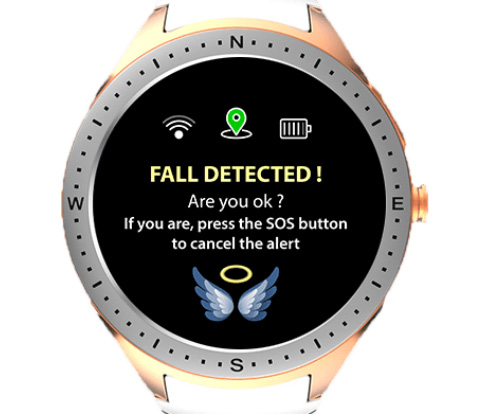
Picture Source: https://docs.wixstatic.com/ugd/c4d649_7d3a1328afa949879c7ad17d93709cae.pdf
Smart City goal: Comprehensive perspective
Another reason that these applicants advocate for a smart city approach to health is because smart city initiatives are expected to facilitate a more comprehensive approach to health and wellness. The Smart City Challenge applicants identify multiple determinants of health and wellness. These determinants include social, mental, physical and economic factors, among others. As part of this broader perspective, these applications do not focus exclusively on technology, but emphasize the need for other types of interventions. Edmonton, for example, points to the importance of “non-technical components” that work along with technology to “complete a Smart City ecosystem and become catalysts for innovation. These components range from the creation of public spaces where residents can come together to gain a sense of community belonging to the partnerships that will continue to drive the transformation of today’s urban physical and digital environments.” With the objective of encouraging healthy behaviours, Airdrie proposes transforming the built environment. They plan to become a “Blue Zones” community. Blue Zones are areas optimized to help residents make healthy choices and adopt healthy behaviors. In these zones, the City and provincial health agency can collaborate with local developers and implement “comprehensive built environment policies aimed at creating communities for healthy living.” They suggest that the community’s health goals be incorporated into the land use planning process; new communities will be “planned with connection in mind – pathways, shopping and recreation are in walking distance no matter where you are and access to healthy choices are easy.” The Blue Zones initiative includes performance measurements that will facilitate effective implementation of the smart city project. Côte Saint-Luc’s preliminary proposal focuses primarily on maintaining seniors’ safety in their home, but their finalist application presented an expanded vision that aspires to reduce seniors’ social isolation, and associated health impacts.
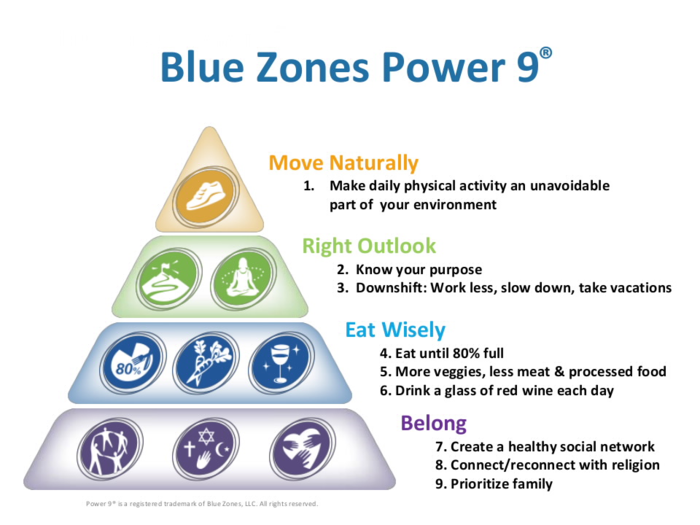
Picture Source: https://www.airdrie.ca/getDocument.cfm?ID=5883
Conclusions
These proposals reveal that, although Canadian cities are not primarily responsible for health care provision, these SCC applicant cities recognize the significant influence that urban environments can have on the health of their residents. These applications also reveal that the expense and complexity of health care makes it a clear choice for projects that use new and innovative approaches. While cities have only begun to think about how they can use connected data and technology to improve their residents’ health, these efforts will certainly continue. In order to support these efforts, more research is needed to explore what types of interventions are most likely to have the greatest positive impact. Little is currently known, for example, about the efficacy of digital applications for improving feelings of social connectedness. Although such research has begun (McKinsey 2018), much more needs to be done to support cities and help ensure that they have the information they need to invest their money and effort wisely.

Urban China is cooperated and participated by the Ministry of Construction, Tongji University, Qinghua University, Beijing University, Zhongshan University, Guangzhou Academy of Fine Arts, Chongqing University, etc. We illustrate urban development from political, economic, social and humane perspectives. Our team is mastered by experts from architecture design and urban planning, and our contents are edited by experienced senior editors with sensitivity to urban development. Our headquarter locates in Shanghai and we use synchronous and co-ordinated editing methods in Shanghai, Guangzhou, Beijing and Chongqing.
Registration information